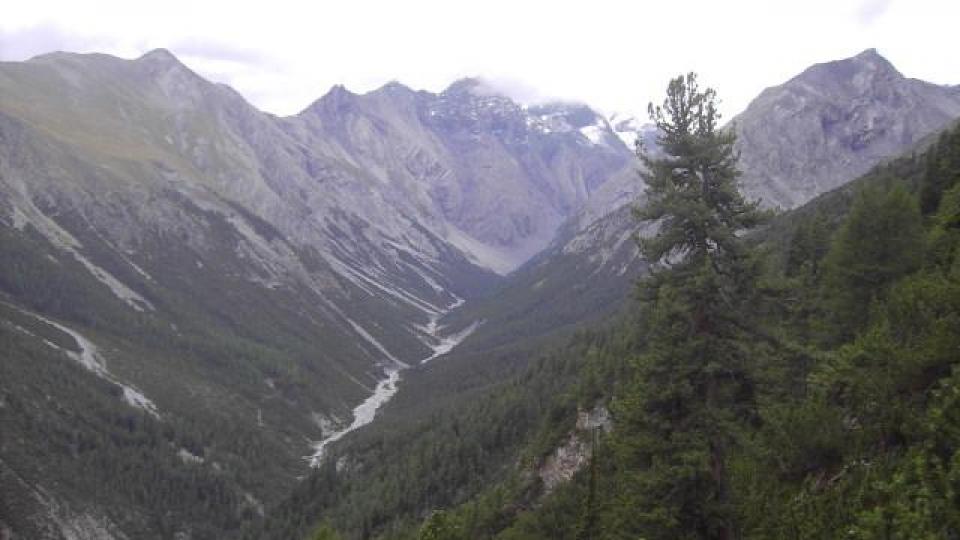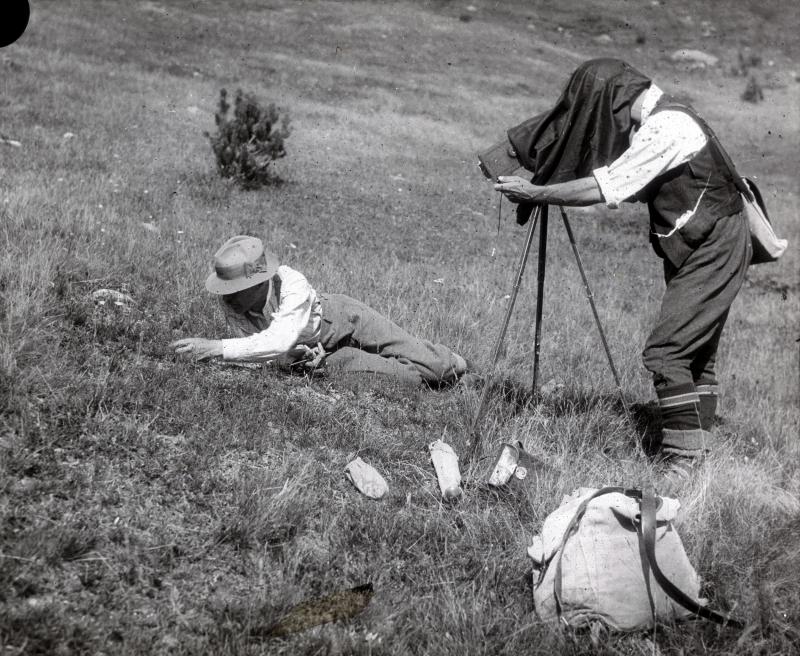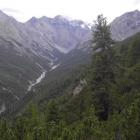
View of the Val Cluozza in the Swiss National Park. Photograph by Patrick Kupper, 2007.
View of the Val Cluozza in the Swiss National Park. Photograph by Patrick Kupper, 2007.
 This work is licensed under a Creative Commons Attribution-NonCommercial-ShareAlike 3.0 Unported License.
This work is licensed under a Creative Commons Attribution-NonCommercial-ShareAlike 3.0 Unported License.
Between 1909 and 1914 a group of Swiss scientists and conservationists managed to designate an area of approximately 14,000 hectares in the Swiss Alps as a national park. In an article in Nature, leading park scientist Carl Schröter declared the location in the Ofenpass district as particularly suitable: “In wildness and naturalness, as in loneliness and seclusion, it is scarcely surpassed anywhere in Switzerland.” Unlike the national parks in the United States, whose regulations Schröter considered insufficiently protective, the Swiss park was meant to be a “complete nature reserve”:
“Human interference is absolutely excluded from the whole region. Hunting, fishing, manuring, grazing, mowing and wood-cutting are entirely prohibited. No flower or twig may be plucked, no animal killed and no stone removed; even the fallen trees must remain untouched. In this way absolute protection is secured for scenery, plants, and animals; Nature alone is dominant.” — Carl Schröter, 1923

Long-term monitoring of vegetation change, a key element of research, included taking photographs (ca 1920)
Long-term monitoring of vegetation change, a key element of research, included taking photographs (ca 1920)
All rights reserved © Courtesy of State Archives Basel-Stadt, PA 924a O 2.1b (1) 160.
The copyright holder reserves, or holds for their own use, all the rights provided by copyright law, such as distribution, performance, and creation of derivative works.
The motivation for these strict rules was partly moral, but mainly scientific. The park should serve as a large outdoor laboratory where natural processes could be observed undisturbed by human interference. Schröter and his colleagues spoke of “a grandiose experiment to create a wilderness.” In the park they hoped to witness a process of “retrograde succession” leading gradually to the reestablishment of “the old primitive biocenosis” as it had existed before civilized man set foot in the Alps. Spectacular sights and exceptional phenomena were of less importance. Unlike in the US, Switzerland’s national parks were not meant to attract large-scale tourism. On the contrary, the rapid development of Alpine tourism and the opening up of mountain tops by cog railways accentuated the plea for large Alpine reserves.
As the Swiss National Park shows, the criterion of seclusion also entailed practical benefits. The whole area was sparsely populated and the revenues from forestry and grazing were small. Therefore, the land-owning local communes agreed on long-term leases for relatively modest compensation. Suitability and practicability went hand in hand.
The early Swiss conservation movement promoted park creation as both a national and an international endeavor. Its leader, Paul Sarasin, simultaneously campaigned for parks in Switzerland and for what he called “Weltnaturschutz” (global nature conservation). The Swiss park was his model for what should be achieved by every state and result in a world-wide web of reserves, an aspiration that was soon hampered by World War I. Scientific research became the hallmark of the Swiss National Park and made it an important model for the establishment of protected areas elsewhere. It provided an alternative prototype to the dominant US national park concept, emphasizing the use of parks for scientific research rather than tourism. Nowadays, the IUCN (International Union for Conservation of Nature) classifies the Swiss National Park not as “national park” (category II) but as a “strict nature reserve” (category Ia).
How to cite
Kupper, Patrick. “The Swiss National Park: A Model of Nature Conservation for Scientific Research.” Environment & Society Portal, Arcadia (2013), no. 7. Rachel Carson Center for Environment and Society. https://doi.org/10.5282/rcc/5271.
ISSN 2199-3408
Environment & Society Portal, Arcadia
 This work is licensed under a Creative Commons Attribution-NonCommercial-ShareAlike 3.0 Unported License.
This work is licensed under a Creative Commons Attribution-NonCommercial-ShareAlike 3.0 Unported License.
2013 Patrick Kupper
This refers only to the text and does not include any image rights.
Please click on the images to view their individual rights status.
- Kupper, Patrick. "Science and the National Parks: A Transatlantic Perspective on the Interwar Years," Environmental History 14, no. 1 (2009): 58-81.
- Kupper, Patrick. "Translating Yellowstone: Early European National Parks, Weltnaturschutz and the Swiss Model," in Civilizing Nature: National Parks in Global Historical Perspective, edited by Bernhard Gissibl, Sabine Höhler, and Patrick Kupper, 123-139. New York: Berghahn Books, 2012.
- Kupper, Patrick. Creating Wilderness: The Transnational History of the Swiss National Park. New York: Berghahn Books, 2014.
- Sarasin, Paul. Ueber die Aufgaben des Weltnaturschutzes: Denkschrift Gelesen an der Delegiertenversammlung zur Weltnaturschutzkommission in Bern am 18. November 1913. Basel: Helbing und Lichtenhahn, 1914. View PDF
- Schröter, Carl. "The Swiss National Park," Nature, 29 September 1923, 478-481.
- Sheail, John. Nature's Spectacle: The World's First National Parks and Protected Places. London: Earthscan, 2010.









